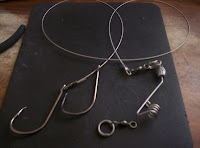
On Monday evening Robert and I decided to go fish of the rocks at Victoria Bay for some shad for the pan while I slide out a bait for my raggie.
Arriving there I met up with another one of my fishing friends, Ian. He was busy spinning with a spoon and the shad was taking it eagerly.
There was lots of bait fish and shad in the water so I thought I might get lucky with a big shark...I WAS WRONG. I slid out a whole shad but nothing picked it up. I have a idea that the other shad ate it off piece by piece with their razor sharp teeth.
At least we had great fun with the shad on light tackle. The thing that I found disturbing is all the left over nylon and plastic bags on the rocks left behind by the previous anglers. And the smell of the rotten bait. Come on guys. Plastic is very light. Carry it back home with you or at least to the closes dustbin.
And nylon line just being left on the rocks. That's plain stupid. And dangerous.
"While some marine debris breaks down fairly quickly, plastic debris can take the longest to break down:
paper towel 2-4 weeks
Styrofoam cup 50 years
Plastic bottle 450 years
Mono filament fishing net 600 years"
Go have a look here and realise what you are doing to nature.http://www.environment.gov.au/minister/env/2004/mr10mar04.html
At 9 when we decided to go home we got stopped by a marine inspector. They were very friendly and polite and wanted to check our fishing permits and fish(for size and bag limits) Lucky me received a R300.00 fine for not having my permit on me. For some stupid reason I did not put it back into my fishing bag.
So learn from my mistake. Take your permit with you on your trips and if you still don't have one GO BUY ONE. It's only R65.oo for a full year(available at any post office) Instead of a R300.00 fine you can pay your permit for 4 years and still have change for hooks and bait. And don't be rude to the inspectors. They are only doing their jobs. If they don't protect the ocean resources we won't have anything left to catch. And I won't start to play golf now.
Anyway, we are planning a trip to beautiful Glentana for Friday. I'll keep you posted on that and take some nice photo's





.jpg)








